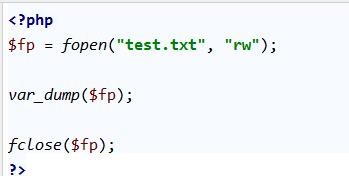8 course recommendations on resource data types
What is a resource data type? Resource data type is introduced by PHP4. Resource is a special variable type, which preserves a reference to external resources: such as opening files, database connections, graphic canvas areas, etc. Resources are established and used through special functions. The use of resource variables in PHP is $ fp = fopen ("test.txt", "rw"); var_dump ($ fp); fclose ($ fp); Print results: Resource (5) of Type (Stream) Number 5: It means that the resource ID is 5, and the specific meaning is introduced later. Stream: Resource type name. In the resource ID kernel, the registered resource variables are stored in a Hashtable and the key in the Hashtable where the resource is located is used as the resource ID. Therefore, in fact, the resource variable in PHP actually stores a whole
## 1. PHP: Resource (Resource) Data Type Examples detailed explanation

This profile: The type of resource data is introduced by php4. Resource is a special variable type that holds a reference to an external resource: such as an open file, database connection, graphics canvas area, etc. Resources are created and used through specialized functions.
2. [Translation][php extension development and embedded] Chapter 9 - Resource Data Type
Introduction: So far, you have been working with very basic user space data types, strings, numeric values, TRUE/FALSE and other values. Even if you learned in the previous chapter I have started to come into contact with arrays, but I have only collected arrays of these basic data types.
3.php extension and embedding--resource data type 2_PHP tutorial
Introduction: PHP extension and embedding--resource data type 2. Complex data types stored in resource variables often require some memory allocation, CPU time, or network communication during initialization. But retain resources similar to database connections between requests
4.php extension and embedded resource data type 2
Introduction: PHP extension and embedding--resource data type 2. Complex data types stored in resource variables often require some memory allocation, CPU time, or network communication during initialization. But retain resources similar to database connections between requests
5.php extension and embedding - resource data type 2
Introduction: Complex data types stored in resource variables often require some memory allocation, CPU time, or network communication during initialization. But retaining resources like database connections between requests must be durable. Durability of resources is a factor that must be considered. First look at ##6.
[Translation][php extension and embedded] Chapter 8 - Resource Data Type
Introduction: [Translation] [php extensions and embedded] Chapter 8 - Resource Data Types Download address of pdf document of all translation contents: http://download.csdn.net/detail/lgg201/5107012 This book is currently translated on github by laruence (http://www.laruence.com) and walu (http://www.walu.cc). 7.
php expansion and embedding-resource data type 2
Introduction: php expansion and embedding--resource data type 2 is stored in resource variables. Data types usually require some memory allocation, CPU time, or network communication during initialization. But retaining resources like database connections between requests must be durable. The durability of resources is a factor that must be considered. First look at the issue of memory allocation: When using PHP, I prefer to use emal##8.
###Introduction: [Translation] [php extension and embedded] Chapter 8 - Resource data types All translation content pdf document download address: http://download.csdn.net/detail/lgg201/5107012 book It is currently translated on github by laruence (http://www.laruence.com) and walu (http://www.walu.cc). The translation project is
The above is the detailed content of 8 course recommendations on resource data types. For more information, please follow other related articles on the PHP Chinese website!

Hot AI Tools

Undresser.AI Undress
AI-powered app for creating realistic nude photos

AI Clothes Remover
Online AI tool for removing clothes from photos.

Undress AI Tool
Undress images for free

Clothoff.io
AI clothes remover

Video Face Swap
Swap faces in any video effortlessly with our completely free AI face swap tool!

Hot Article

Hot Tools

Notepad++7.3.1
Easy-to-use and free code editor

SublimeText3 Chinese version
Chinese version, very easy to use

Zend Studio 13.0.1
Powerful PHP integrated development environment

Dreamweaver CS6
Visual web development tools

SublimeText3 Mac version
God-level code editing software (SublimeText3)

Hot Topics
 Alipay PHP SDK transfer error: How to solve the problem of 'Cannot declare class SignData'?
Apr 01, 2025 am 07:21 AM
Alipay PHP SDK transfer error: How to solve the problem of 'Cannot declare class SignData'?
Apr 01, 2025 am 07:21 AM
Alipay PHP...
 Explain JSON Web Tokens (JWT) and their use case in PHP APIs.
Apr 05, 2025 am 12:04 AM
Explain JSON Web Tokens (JWT) and their use case in PHP APIs.
Apr 05, 2025 am 12:04 AM
JWT is an open standard based on JSON, used to securely transmit information between parties, mainly for identity authentication and information exchange. 1. JWT consists of three parts: Header, Payload and Signature. 2. The working principle of JWT includes three steps: generating JWT, verifying JWT and parsing Payload. 3. When using JWT for authentication in PHP, JWT can be generated and verified, and user role and permission information can be included in advanced usage. 4. Common errors include signature verification failure, token expiration, and payload oversized. Debugging skills include using debugging tools and logging. 5. Performance optimization and best practices include using appropriate signature algorithms, setting validity periods reasonably,
 How does session hijacking work and how can you mitigate it in PHP?
Apr 06, 2025 am 12:02 AM
How does session hijacking work and how can you mitigate it in PHP?
Apr 06, 2025 am 12:02 AM
Session hijacking can be achieved through the following steps: 1. Obtain the session ID, 2. Use the session ID, 3. Keep the session active. The methods to prevent session hijacking in PHP include: 1. Use the session_regenerate_id() function to regenerate the session ID, 2. Store session data through the database, 3. Ensure that all session data is transmitted through HTTPS.
 What are Enumerations (Enums) in PHP 8.1?
Apr 03, 2025 am 12:05 AM
What are Enumerations (Enums) in PHP 8.1?
Apr 03, 2025 am 12:05 AM
The enumeration function in PHP8.1 enhances the clarity and type safety of the code by defining named constants. 1) Enumerations can be integers, strings or objects, improving code readability and type safety. 2) Enumeration is based on class and supports object-oriented features such as traversal and reflection. 3) Enumeration can be used for comparison and assignment to ensure type safety. 4) Enumeration supports adding methods to implement complex logic. 5) Strict type checking and error handling can avoid common errors. 6) Enumeration reduces magic value and improves maintainability, but pay attention to performance optimization.
 Describe the SOLID principles and how they apply to PHP development.
Apr 03, 2025 am 12:04 AM
Describe the SOLID principles and how they apply to PHP development.
Apr 03, 2025 am 12:04 AM
The application of SOLID principle in PHP development includes: 1. Single responsibility principle (SRP): Each class is responsible for only one function. 2. Open and close principle (OCP): Changes are achieved through extension rather than modification. 3. Lisch's Substitution Principle (LSP): Subclasses can replace base classes without affecting program accuracy. 4. Interface isolation principle (ISP): Use fine-grained interfaces to avoid dependencies and unused methods. 5. Dependency inversion principle (DIP): High and low-level modules rely on abstraction and are implemented through dependency injection.
 How to debug CLI mode in PHPStorm?
Apr 01, 2025 pm 02:57 PM
How to debug CLI mode in PHPStorm?
Apr 01, 2025 pm 02:57 PM
How to debug CLI mode in PHPStorm? When developing with PHPStorm, sometimes we need to debug PHP in command line interface (CLI) mode...
 How to automatically set permissions of unixsocket after system restart?
Mar 31, 2025 pm 11:54 PM
How to automatically set permissions of unixsocket after system restart?
Mar 31, 2025 pm 11:54 PM
How to automatically set the permissions of unixsocket after the system restarts. Every time the system restarts, we need to execute the following command to modify the permissions of unixsocket: sudo...
 How to send a POST request containing JSON data using PHP's cURL library?
Apr 01, 2025 pm 03:12 PM
How to send a POST request containing JSON data using PHP's cURL library?
Apr 01, 2025 pm 03:12 PM
Sending JSON data using PHP's cURL library In PHP development, it is often necessary to interact with external APIs. One of the common ways is to use cURL library to send POST�...






